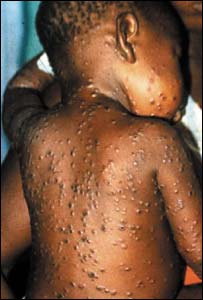Monkeypox is a virus that I have never encountered in my The Woodlands dermatology and Conroe dermatology offices. Monkeypox is endemic to Central and West Africa and its natural host is the African tree squirrel and can infect monkeys, rabbits, mice, and rats. Only rarely does Monkeypox infect humans as there was a case in 2003 in which prairie dogs became infected with Monkeypox and subsequently transmitted it to humans in Wisconsin. As Monkeypox is in the same Orthopoxvirus group as smallpox and vaccinia, the clinical features of a Monkeypox outbreak are very similar to a smallpox/vaccinia disease course. Patients initially develop fever and flu like symptoms 12 days after exposure to Monkeypox, and the rash begins 3 to 5 days later. The main difference between an infection with Monkeypox and smallpox/vaccinia is that patients with Monkeypox develop lymphadenopathy (swollen lymph nodes). Monkeypox can be transmitted from contact with the infected animal or human. The mortality rate is 10% and there is no effective treatment, although previous vaccinia immunizations does provide some protection against Monkeypox.





